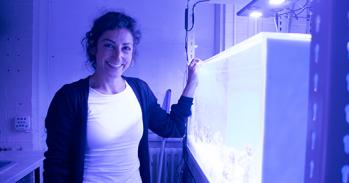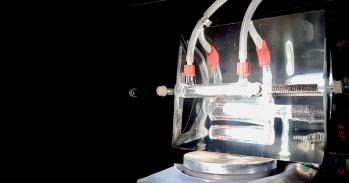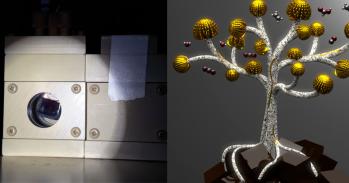
Research will explore using sunlight to convert greenhouse gas carbon dioxide and water to syngas, the precursor to liquid fuel.
Research will explore using sunlight to convert greenhouse gas carbon dioxide and water to syngas, the precursor to liquid fuel.
The approach of the new laboratory aims to develop the basic principles to allow for a renewable production of syngas. Our long-term vision is a transition from a fossil-based to a sustainable carbon-based economy.
Dr Erwin Reisner, Head of the Christian Doppler Laborator
A state-of-the-art laboratory, which aims to use sunlight to power the sustainable conversion of CO2 and water to form syngas, a high-energy gas mixture with potential as a future fuel source, opened this week in the Department of Chemistry.
The Christian Doppler laboratory for Sustainable SynGas Chemistry will address application-oriented basic research questions to facilitate the creation of a sustainable carbon-based economy. It is jointly funded by the Austrian Christian Doppler Research Association (Federal Ministry of Economy, Family and Youth & the National Foundation for Research, Technology and Development) and the OMV Group for a period of seven years.
The lab will research ways to use light from the sun to power the sustainable conversion of the greenhouse gas carbon dioxide and water to form syngas, a high-energy gas mixture containing hydrogen, H2 (an attractive fuel on its own), and carbon monoxide, CO. Syngas is a valuable gas mixture and, importantly, it can be transformed into liquid hydrocarbons ('gasoline'), also known as liquid fuels.
Despite its potential as a future fuel source, syngas is already used as an invaluable chemical feedstock for the petrochemical industry, as an intermediate for the production of many chemicals such as H2, methanol and ammonia. Unfortunately, current production of syngas is non-renewable; it is produced on a mega-ton scale by the energy-intensive steam reforming of fossil fuels, and subsequent H2 to CO ratio adjustment by the water-gas shift reaction. This unsustainable process yields fuel cell grade H2 and the greenhouse gas CO2.
Dr Erwin Reisner, Head of the Christian Doppler Laboratory, said: “The approach of the new laboratory aims to develop the basic principles to allow for a renewable production of syngas. Our long-term vision is a transition from a fossil-based to a sustainable carbon-based economy.”
The CD-laboratory will focus on developing molecular catalysts, which will ultimately be integrated in nanostructured materials for syngas generation. This approach will allow for the assembly of a small-scale device for solar syngas production. The CD-laboratory will operate with an exceptional cross-disciplinary approach at the interface of bio-inspired molecular and materials synthesis, advanced electrochemistry, photochemistry and nanodevice engineering. The proposed research project combines a high degree of novelty with potentially enormous impact on academic science, industry and society.
The Christian Doppler Research Association is a non-profit organization that supports basic science and technology to economically relevant questions. The OMV Group is an Austrian-based oil refining company with important global activities.
This work is licensed under a Creative Commons Licence. If you use this content on your site please link back to this page.





